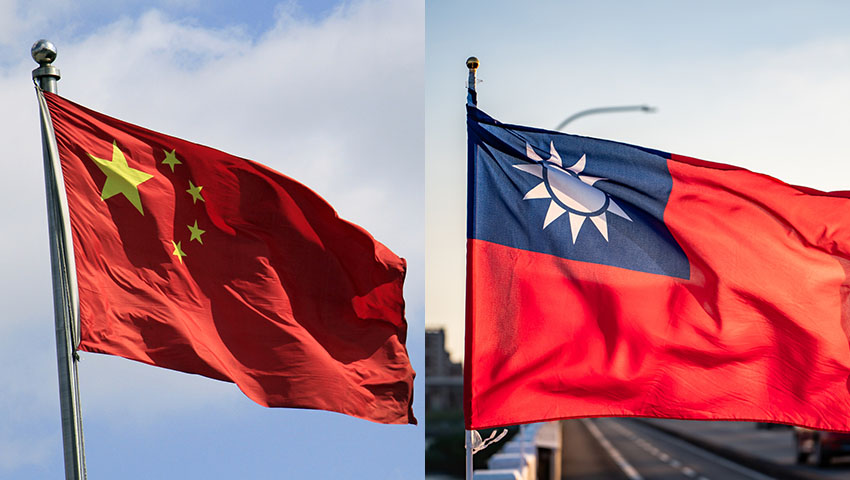Mounting tensions between Beijing and Taipei have heightened the possibility of a full-scale military confrontation, but how would a potential clash unfold?
To continue reading the rest of this article, please log in.
Create free account to get unlimited news articles and more!
Over the past month, China has repeatedly breached Taiwan’s south-western air defence verification zone (ADIZ), in what has been widely understood to be an act of provocation.
This ramp up in aggression has prompted fears of an imminent military confrontation between the communist regime and the democratic republic.
Charlie Lyons Jones, Elena Yi-Ching and Malcolm Davis, analysts from the Australian Strategic Policy Institute (ASPI), explore how a military confrontation might unfold.
The ASPI analyst consider whether Beijing would “move decisively” to a full-scale invasion by depending on its anti-access, area-denial (A2/AD) capabilities, which would “raise the cost of US intervention to unacceptable levels”.
“The goal would be to present a fait accompli to Washington and prevent US military intervention by threatening unacceptable losses,” the analysts observe.
The analysts add that alternatively, China may adopt a “coercive strategy”, gradually increasing military pressure in a bid to force the government of Tsai Ing-wen in Taipei to “bend to China’s demand” for unification with the mainland.
“That could involve a series of limited operations: seizure of Taiwan’s offshore islands, such as Kinmen and Matsu, as well as Itu Aba and Pratas islands in the South China Sea; a naval and air blockade around Taiwan; an air and missile campaign; and offensive cyber operations against Taiwan’s critical infrastructure,” they continue.
But according to the ASPI analysts, Beijing has other tools at its disposal.
“If China decided on a more graduated path of escalating pressure, it might seek to use military force in the grey zone first, below a level that would automatically generate a US military response but strong enough to test the resolve of the Biden administration, while exploiting the deterrent potential of A2/AD to insure against any US intervention,” the analysts note.
This move, they write, may force the US to question the utility of rising US lives and assets to respond to grey zone attacks, which may include a Chinese landing on Pratas Island in the South China Sea or large-scale cyber attacks on Taiwan’s critical information infrastructures.
“China might be betting that Biden wouldn’t risk a major military crisis, with huge potential for rapid escalation, over a limited action by the PLA,” the analysts write.
But they warn that if the US fails to intervene, Beijing may be encouraged to expand its reach, capturing territories such as Kinmen or Matsu, while imposing an air and naval blockade on Taiwan.
“A graduated campaign of escalation would ensure that China maintains the initiative. It would be matched by coercive economic and political pressure on China’s neighbours, and even US allies such as Australia, not to support any US military response,” they write.
“The use of ‘sharp power’ would coincide with the use of hard power in the form of military force directly against Taiwan’s interests.”
The ASPI commentators then explore the timing of a potential move from President Xi Jinping to launch a campaign of graduated escalation.
Citing a China Matters policy brief by Linda Jakobson, the analysts note that the Chinese Communist Party hinted at a plan to openly advance the process of unification under the ‘One Country, Two Systems’ plan for Taiwan from between 2020 and 2025.
“The period between now and 2025 is likely to be one of heightened strategic danger,” the ASPI analysts add.
However, the ASPI pundits observe that there is short window each year in which China could conduct large-scale military operations against Taiwan.
“As Ian Easton of the Project 2049 Institute has noted, conditions in the Taiwan Strait are only suitable for PLA amphibious operations between March and May, and April would be the best time of year to launch an invasion,” they continue.
“We can thus expect the US military to be at heightened levels of readiness between March and May from now through to 2025.”
However, the analysts acknowledge that there are reasons to doubt that the PLA would be prepared to launch an amphibious assault against Taiwan in the next five years.
“For instance, the PLA has serious doubts about its ability to think through, train for and launch complex naval operations,” they note.
The ASPI analysts go on to cite an article in the PLA Daily, which quoted the results of a meeting on naval operations held by the PLA Navy’s submarine training centre.
Participants claimed that “research into maritime tactics isn’t deep and lacks [insight into] methods of tactical command”, and conceded that “battlefield training gives much consideration to safety, but gives little consideration to the enemy’s circumstances”.
“Senior PLAN leaders clearly believe that the fleet isn’t capable of planning for the myriad contingencies that could eventuate during a naval operation as complex as an amphibious assault,” the ASPI analyses state.
“To meet Xi’s ambitious timetable, it’s likely that the CCP will be placing serious pressure on the PLAN to resolve those issues as soon as practicable.
“Ultimately, the PLA’s doubts about its own combat capability might not be enough to dissuade Xi’s Central Military Commission from taking some sort of coercive action against Taiwan.”
According to reports from Reuters and from Wen Li on 9 Dash Line, China is mounting a number of grey-zone operations, including land reclamation and the proposed construction of water, electricity and gas pipelines near Kinmen and Matsu.
“Further actions geared towards Beijing assuming administrative control over those islands are to be expected before 2025,” the ASPI analysts add.
“Beijing probably has the capability to launch a Scarborough Shoal–type annexation of Kinmen and Matsu in the near term. And, given that control of those islands would be a prerequisite for a successful amphibious assault on Taiwan, it appears likely that Beijing may seek to seize control of them before 2025.”
The ASPI observers concluded by noting that Beijing would also consider internal developments in Taiwan.
“For instance, Taiwan will hold its nine-in-one local government elections in 2022, followed by a presidential election in 2024,” they write.
“Beijing could try to capitalise on Taiwan being preoccupied with its domestic politics and calculate that further grey-zone or military operations would have a higher probability of success.
“Those are contingencies that the Biden administration will need to think through carefully.”
Get involved with the discussion and let us know your thoughts on Australia's future role and position in the Indo-Pacific region and what you would like to see from Australia's political leaders in terms of partisan and bipartisan agenda setting in the comments section below, or get in touch with
Charbel Kadib
News Editor – Defence and Security, Momentum Media
Prior to joining the defence and aerospace team in 2020, Charbel was news editor of The Adviser and Mortgage Business, where he covered developments in the banking and financial services sector for three years. Charbel has a keen interest in geopolitics and international relations, graduating from the University of Notre Dame with a double major in politics and journalism. Charbel has also completed internships with The Australian Department of Communications and the Arts and public relations agency Fifty Acres.

 Login
Login








